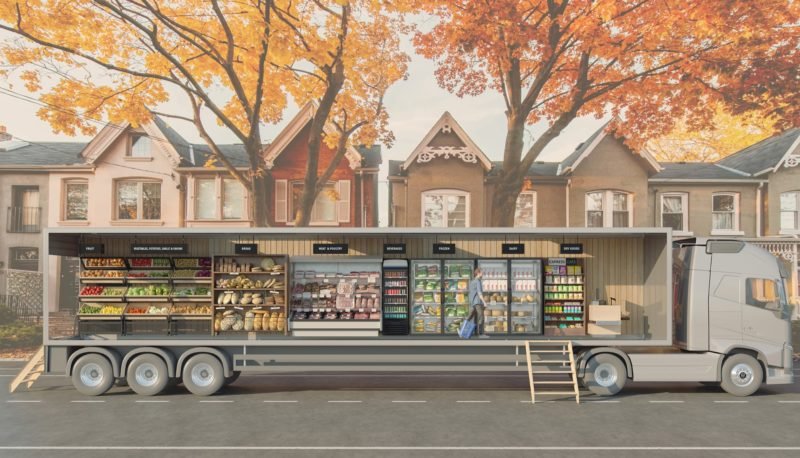Robots Save Declining High Streets
Landscapes of consumption are changing continuously, and we are witnessing many ground-breaking developments. On the one hand, specific niche stores selling products like craft beer, vintage clothing and hipster-like home decoration pop up across cities. On the other hand, there’s the demise of more traditional shops in most (smaller) cities, resulting in abandoned shopping streets and vacant storefronts. There’s light at the end of the tunnel: robots could save the declining high street. But do we want it?
Vending Machines 2.0
The automation of retail is nothing new. We’re all familiar with traditional vending machines that hook you up with a can of soda — at least, if it doesn’t get stuck. As Christopher D. Salyers explains in Vending Machines: Coined Consumerism, a first big wave of vending machines came up around mid-1800. These machines provided you with stuff like stamps, peanuts and cigars.

24/7 flower vending machine
Over time, the products offered by vending machines have also changed. We can all think of traditional vending machine stuff like gum, cigarettes, and soda. But more and more, we find vending machines that make clever use of societal and consumptive trends, paired with technological innovations. Think of 24 Flower, a vending machine in Amsterdam that provides you with a bouquet of fresh flowers any time of the day. It caters a demand of convenience and the non-stop availability of a ‘fresh’ product like flowers. Or how about a machine like Farmer’s Fridge, that dispenses fresh and healthy food instead of snacks?

Cooperative milk vending machines in Greece
We also see that vending machines are a good means for farmers to offer their fresh products to their clientele. In Greece, a cooperation of milk farmers set up a vending machine that hooks up you with fresh milk straight from the farm. Another interesting example is the Egg-o-Mat, a roadside vending machine installed by Hamburg urban farm Hühnerhof der Motte to sell their fresh free-range eggs to locals. Vending machines can be a good way for farmers and local entrepreneurs (e.g. in shrinking regions) to offer their products to others.

Bikestock, a vending machine that dispenses all sorts of spare parts and essentials for cyclists on the move
After having offered a range of basic stuff and being used for means of marketing and entertainment, the latest generation of vending machines take consumption to a next level. Offering fresh and new products, increasing consumers’ convenience by making these products 24/7 available, and creating a do-it-yourself environment, vending machines could gradually replace traditional stores and services (if they aren’t already doing so).

Clifton’s electronic grocery store
Local village shops are a staple part of life for most village residents in the UK. However, recent years have seen a decline in such establishments, including Clifton, who have been without their local shop for 13 years. In 2014 a giant vending machine was installed a replacement for a grocery store. The “electronic shop” stocks a wide range of products, including necessitates such as bread, milk, cheese and pet food. Able to pay in cash or on card, the residents of Clifton are enjoying putting money back into their local community as well as the convenience of not having to drive to a bigger town.

In London, this kebab robot does all the hard work
Restaurant Tech
Other trends in the automation of retail are also unfolding rapidly. Advanced technologies such as artificial intelligence already make that in some cases restaurants have become partially (or fully) automatized. North London’s Super Kebab makes use of a kebab robot, which slices your döner perfectly thick and very hygienically. Guided by sensors, this robot takes over the job from the staff.

Eatsa is conquering the streets of San Francisco with its fully automated quinoa restaurant
At Eatsa’s fully automated restaurants in San Francisco and Los Angeles you won’t find here any cashiers, let alone queues. Here you order a meal by using an iPad or iPhone. Your name comes up on a transparent LCD screen box, and you pull out your bowl of quinoa. “Our machines aren’t meant to help our employees — they’re meant to make them obsolete,” explained founder Alexandros Vardakostas in an interview with salon.com.

Pizza Hut’s interactive table top
A similar form of robotization is found at Pizza Hut. In a promotional video, they show one of their table that has a touchscreen table-top. With this, guests can create their own pizza from scratch. It brings fun, convenience, and at the same time it leaves no need for real personnel to take orders. Again, advanced technology with a strong influence on aretail and consumption. Makes us wonder: how does your pizza get at your table? Probably they’ll have a robot for that too.

Eatsa
Automation of Retail
Through all these varying examples, we see an automation of retail that develops itself in full speed. Whether it are new types of vending machines that help increase consumptive convenience, offering fresh and healthy products 24/7, or technology that changes our traditional ideas of ordering and preparing food in restaurant — it’s clear that retail landscapes and practices of consumption are strongly influenced by a sense of automation. One could say that this leads to a loss of jobs, when there’s no longer a need for waitresses or chefs. On the other hand, think of the possibilities these developments can have for farmers, entrepreneurs, or shop-owners in shrinking urban regions. Automation of retail is a trend we feel we’ll have to keep a close eye on in the coming future.
This article is part of Pop-Up City’s urban trends for 2016. Reflecting on what we’ve written in 2015 and looking into the new year, we’ve created a list of five remarkable urban trends in the coming year. Contact us if you’re interested in hearing more.



